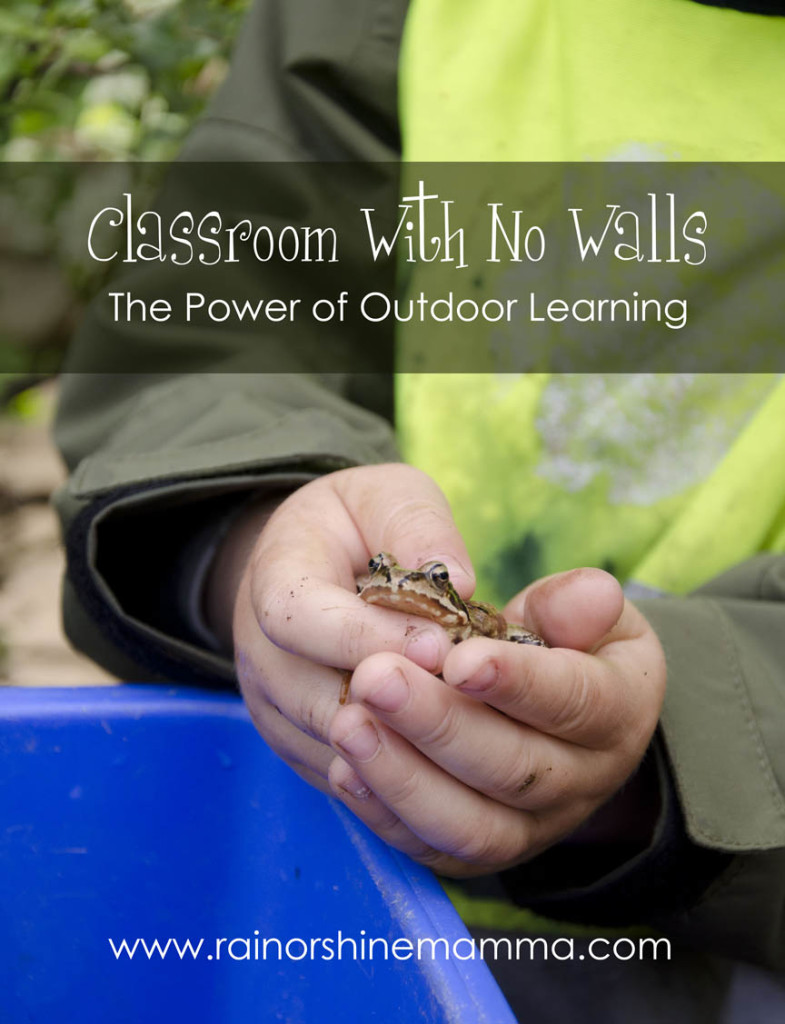At the edge of a sprawling pine forest in southern Sweden, a blond boy who is just shy of his second birthday fearlessly scales some tall, moss-clad boulders like it was nobody’s business. Below the rocks, three brothers wearing rain boots are wading around in a creek and building a habitat for a frog they just found. Nearby, I watch as a group of preschool-aged girls are busy racing pine cones down a repurposed waterspout.
There is no fence in sight and the boundaries mainly consist of natural features – the creek, the grove of birch trees, the wind break and so on. The adults in charge are supervising from a distance, while cutting up some fresh pears and apples for a mid-morning snack. There is a building on the property – but it is used sparingly since the children play, learn and often eat outdoors every day – rain or shine. Welcome to forest school, Scandinavian style!
Outdoor learning in Europe
I grew up in Scandinavia, where the first forest schools, or outdoor nurseries, started cropping up in the 1950s. Although I didn’t attend one myself, my friends and I were raised in the same nature-loving culture that inspired the forest schools. My hometown is roughly on the same latitude as Juneau, Alaska, but we played outside all year round, cheered on by parents and teachers who would all respond with the old Scandinavian catch phrase “There is no bad weather, only bad clothes!” should we ever complain. (A phrase which, by the way, continues to guide this blog.)
After moving to the US and having children of my own, my interest in forest schools and their practices and principles started to grow. The main goal of outdoor nurseries/preschools in Scandinavia is to forge a bond between children and nature, so that the children will become knowledgeable about the environment and take good care of it as adults. As it turns out, there’s plenty more to like about them.
“We’ve found that children at forest schools have significantly fewer sick days and better motor skills, and they’re fitter and more attentive than children at traditional preschools,” says Patrik Grahn, a landscape architect and biologist at the Swedish University of Agricultural Sciences (SLU) who conducted one of the first groundbreaking studies on forest schools back in 1997.
In nature, children’s interactions also tend to become more imaginative and allow for elaborate role-playing games. “Play in itself has a therapeutical effect on children,” says environmental psychologist Fredrika Mårtensson at SLU. “And they play differently outside. The games are more open and flexible, and it’s easier for them to organize the situation in a way that’s beneficial to them physically, socially and psychologically.”
Outdoor learning at forest school
In Sweden, forest schools seem to be particularly popular among parents who themselves enjoy an outdoorsy lifestyle. “I think it’s great that they’re outside in the fresh air instead of inside with all the germs,” says Malin Utter, whose three children (aged 1.5, 5 and 7) are all attending an outdoor nursery and after school program. “Plus, they run off a lot of excess energy.”
Forest schools are common in Europe, especially in Germany, which according to Der Spiegel boasts over 1,500 so called waldkindergartens. They are also surging in popularity in countries like the UK, South Korea and Japan. In Sweden outdoor nurseries recently got a boost as the youngest member of the royal family, Princess Estelle, 2,5, enrolled for her first semester at a cooperative forest school. “For us it is very important that nature becomes a natural part of the children’s everyday life,” Estelle’s mother, Crown Prince Victoria, told Radio Sweden as she accompanied her daughter to the first day of school.
Play-based learning
Learning at forest schools is less focused on traditional academic subjects and is typically child-led, play-based and rooted in hands-on experience. It is also naturally interdisciplinary, according to Juliet Robertson, founder of Creative STAR Learning Company and a leading outdoor education consultant in Scotland. “I would argue that the experience is richer when it takes place outside,” she said about outdoor classrooms.
For example, Robertson said, if children use leaves to learn how to count objects, they may learn to identify that type of leaf and the plant from which it came. They may also learn that on windy days, leaves blow away if you don’t hold them tightly or put a stone on top, so they need to be more adaptable to environmental circumstances. They will have collected the leaves in order to count them. This means making a decision that directly impacts on the environment – do they pick leaves growing from a plant, and if so which one? Or, do they only collect leaves that have fallen on the ground?
“You learn none of these things in a classroom counting plastic elephants,” Robertson said.
Compared with Europe, the forest school movement in North America has been slow to catch on, and in the U.S. there are only a couple of dozen nature preschools in operation. So what if you’re not one of the fortunate few who live near one? Try to encourage your child’s preschool or daycare provider to get outside more. And if your children are in grade school, promote the idea of an outdoor classroom to the parent teacher organization or administration. More importantly, “Make time outside of school for lots of outdoor experiences,” Robertson advised.
If you’re in need of ideas for outdoor learning, check out Nature Rocks, the Children and Nature Network and Be Out There, as they are all great resources for connecting children with nature. Hopefully you’ll also be inspired by my DIY Forest School series here on the blog. If you missed the first two posts, I’ve previously written about counting with nature and exploring small worlds.



I like the idea, but playing outside in almost all weathers has to be adaptable.
I’m from Texas. Rain = thunderstorms. Houston is old swamp land and the region has frequent flash floods. I actually get spooked by heavy storms (block out sun) and no thunder, because the 2 times a tornado missed the building I was in and hit the one next door we had those conditions.
The kids in my family (nieces, nephew, assorted cousins) will play happily in what we call a sunshower. (Light rain, you can still see the sun). First crack of thunder and they get their rears inside. Heat lightning means watch the sky, because it is lightning from a storm so far away the sound doesn’t reach us. It could mean a thunderstorm is racing our way.
I totally agree that the weather has to be safe for the kids to be outside. Although winters in Scandinavia can be harsh, dark and long, the region is fortunately spared from extreme weather like tornadoes and hurricanes and rarely experiences severe storms and flash floods. So the concept needs to be adapted to the climate of each individual region. That said, I think traditional schools and preschools could gain a lot from taking more of their teaching outside. Kids today spend very little time outside, even on days when the weather is nice.
Hi, this post was of real interest to me. I am currrently training to become a Forest School Leader. I have my folder to hand in next month and fingers crossed it’ll all be good. The training was amazing and I had the most enjoyable week, it really showed me how important and benefical outdoor learning is for children’s development.
I am passionate about outdoor experiences for children, and through the children I work with and also with my daughter, I see the fun, the confidence and the postivite development they acheive with the chance to be in the outdoors.
A great post, really glad I had the chance to read. Thank you.
Kim, I’m glad you liked the post and I’m so excited about your journey to become a forest school leader! I just signed up for your newsletter, so that I can follow your progress. And yes, outdoor learning really is a fantastic thing for kids – both for their development and physical and psychological well-being. Thanks for stopping by!
Congrats on being a Nature Rocks contributor. I wish the forest school idea was catching on here. For now I will continue to do things with my son.
Thanks, Mae:o) And yes, I can only hope but unfortunately it doesn’t feel like the educational policies of this country are heading in that direction, rather the opposite with pushing more academics earlier and earlier, rather than promoting outdoor play and learning. Like you, I just try to make up for it as much as possible at home, but it’s definitely not easy when the school days are long and there is a lot of homework to be done.
Brilliant post. Forest schools is such an amazing concept, one I fell in love with when I did the training. It is a magical experience and being out in nature every day playing and learning has a profound effect on almost everyone who takes part. Thanks so much for sharing at the Outdoor Play Party 🙂
I didn’t know you’re a trained forest school leader – that’s so exciting! I do love being outside with the kiddos and I can see the positive impact that it has on them. Thanks for reading.
Hi Linda, I totally agree that some of the best childhood memories are created outdoors! I have deeply considered this idea since I learned about the development of ‘farm schools’ during the post war period to help children recover from the traumas of war, while I studied ECE courses. I have witnessed over and over again how children respond and learn while interacting with the natural elements outside. There are always enough play materials for everyone! I am laying the groundwork to begin developing an outdoor preschool for the southern interior of BC, Canada. It seems like a big thing to jump into as this is a pretty new idea here and licensing regulations are pretty rigid. I would love to hear any advice you might have in starting up an outdoor program
Hi Lorinda – Sorry about the tardy response. I’m glad to hear that you’re considering the idea of an outdoor preschool in BC; I’m seeing this approach gain momentum across both Canada and the US right now, so I think the time is ripe. I’m not familiar with the licensing requirements in Canada, but the Manitoba Nature Summit has a lot of great info: http://www.naturesummitmb.com/. Cedarsong Nature School (http://cedarsongnatureschool.org/) also offers training for new forest school teachers. My general advice would be to study the original European model in depth, since it’s such a different way to approach early childhood education. Being outdoors is one of the most important components of forest schools, but there is also the whole child-led approach, which is equally important. Best wishes to you – I’m sure you’ll do great!